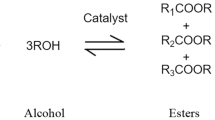Abstract
Oil debris count is an important health monitoring parameter in aero gas turbine engine. Present paper deals with the oil debris analysis collected from the bearing houses and gear box of a military gas turbine engine. Due to relative motion between stationary parts, wearing-out has taken place in turbine bearing house. Improper assembly or dimensional inaccuracies found to be the root cause of high debris generation. For wearing-out of the drive shaft in gear box, lapses in assembly procedure and improper tolerances are found to be responsible. Though high ‘g’ maneuvers of the aircraft, hard landings, missile launch and bird hit or foreign object impact can lead to such high debris in the oil circuit, utmost care needs to be taken during assembly.






















Similar content being viewed by others
References
H.I.H. Saravanamuttoo, G.F.C. Rogers, H. Cohen, Gas Turbine Theory (Pearson Education, London, 2001)
P.P. Walsh, P. Fletcher, Gas Turbine Performance (Wiley, London, 2004)
R. Bhaskar, Aircraft Propulsion (Elsevier, India, 2008)
T. Tauber, Full-flow debris monitoring in gas turbine engines, in ASME paper, (1981), pp. 9–12
R.F. Orsagh, J. Sheldon, C. Klenke, Prognostics/diagnostics for gas turbine engine bearings, in Proceedings of IEEE Aerospace Conference (2003)
T.H.C. Childs, A. Mimaroglu, Sliding friction and wear up to 600 C of high speed steels and silicon nitrides for gas turbine bearings. Wear 162, 890–896 (1993)
I. Salam, A. Tauqir, A.U. Haq, A.Q. Khan, An air crash due to fatigue failure of a ball bearing. Eng. Fail. Anal. 5(4), 261–269 (1998)
R.K. Mishra, S.K. Muduli, K. Srinivasan, S.I. Ahmed, Investigation of an inter-shaft bearing failure in an aero gas turbine engine. J. Fail. Anal. Prev. 15(2), 205–210 (2015). doi:10.1007/s11668-015-9933-8
Y. Diab, F. Ville, P. Velex, Investigations on power losses in high-speed gears. Proc. Inst. Mech. Eng. Part J: J. Eng. Tribol. 220(3), 191–198 (2006)
H.N. Özgüven, D.R. Houser, Dynamic analysis of high speed gears by using loaded static transmission error. J. Sound Vib. 125(1), 71–83 (1988)
J.L. Miller, D. Kitaljevich, In-line oil debris monitor for aircraft engine condition assessment, in 2000 IEEE Aerospace Conference Proceedings, vol. 6, pp. 49–56
P.J. Dempsey, N. Bolander, C. Haynes, A.M. Toms, Investigation of Bearing Fatigue Damage Life Prediction Using Oil Debris Monitoring, NASA/TM-2011-217117 (NASA, Washington, DC, 2011)
L.C. Jaw, Recent advancements in aircraft engine health management (EHM) technologies and recommendations for the next step, in ASME Paper No. GT2005-68625 (2005)
J. Edmonds, M.S. Resner, K. Shkarlet, Detection of precursor wear debris in lubrication systems. in Aerospace Conference Proceedings, 2000 IEEE. vol. 6. IEEE, 2000
D. Scott, Debris examination—a prognostic approach to failure prevention. Wear 34(1), 15–22 (1975)
I. Tauqir, A. Salam, A.Q. Haq, Khan, Causes of fatigue failure in the main bearing of an aero-engine. Eng. Fail. Anal. 7(2), 127–144 (2000)
T.A. Harris, R.M. Barnsby, Tribological performance prediction of aircraft gas turbine mainshaft ball bearings. Tribol. Trans. 41(1), 60–68 (1998)
J. Halme, P. Anderson, Rolling contact fatigue and wear fundamentals for rolling bearing diagnostics—state of the art. Proc. IMechE 224, 377–393 (2009)
N. Ejaz, I. Salam, A. Tauqir, Failure analysis of an aero engine ball bearing. J. Fail. Anal. Prev. 6(6), 25–31 (2006)
A.K. Das, Metallurgy of Failure Analysis (McGraw Hill, NY, 1997)
R. Reichelt, Scanning electron microscopy, in Science of Microscopy. Springer, New York, 2007, pp. 133–272.
Acknowledgment
The authors are very grateful to the Chief Executive, CEMILAC, Bangalore, India, for his kind permission for publishing this paper. The authors are also very thankful to the General Manager and Engineers of Hindustan Aeronautics Limited, Bangalore, and Officers of Aeronautical Quality Assurance (Engines), Bangalore, for their cooperation and support during this study.
Author information
Authors and Affiliations
Corresponding author
Rights and permissions
About this article
Cite this article
Mishra, R.K., Kumar, P. & Prakash, L. Analysis of Oil Debris in an Aero Gas Turbine Engine. J Fail. Anal. and Preven. 17, 1131–1138 (2017). https://doi.org/10.1007/s11668-017-0351-y
Received:
Published:
Issue Date:
DOI: https://doi.org/10.1007/s11668-017-0351-y




